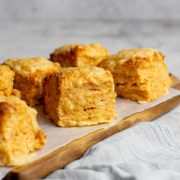
Cheese Scones
These easy, light and fluffy cheese scones come together in a matter of minutes. Flavoured with cheddar, parmesan and spices, enjoy these scones (biscuits) hot out the oven with a smattering of butter.
Servings6 scones
Equipment
- Baking Tray
- Bench Scraper
- Cookie Cutters
- Pastry brush
Ingredients
- 310 grams plain flour (all-purpose/standard grade)
- 3 teaspoons baking powder
- 60 grams butter salted
- 50 grams parmesan (grated)
- 100 grams cheddar (grated)
- 200 mL milk
- 3 tablespoons milk
- ½ teaspoon mustard powder (optional extra)
- ½ teaspoon cayenne pepper (optional extra)
- 1 teaspoon paprika (optional extra)
- ¼ - ½ teaspoon of table salt (if using unsalted butter)
Instructions
- Preheat the oven to 220°C/200°C Fan. Line a baking tray or baking sheet with baking paper or parchment paper.
- Grate the cheeses, keeping aside 40 grams of the cheddar to place on top of the scones before baking.50 grams parmesan, 100 grams cheddar
- In a large bowl whisk together the flour, baking powder, salt, mustard, cayenne pepper, and paprika. Grate the butter or cut it into small blocks. Rub the butter into the dry ingredients until it resembles fine breadcrumbs with some small pieces of butter scattered throughout the flour (or work the butter into the flour using a pastry cutter). Add the grated cheese into the flour, and mix through with your fingers until well distributed.310 grams plain flour, 3 teaspoons baking powder, 60 grams butter, 50 grams parmesan, ½ teaspoon mustard powder, ½ teaspoon cayenne pepper, 1 teaspoon paprika, ¼ - ½ teaspoon of table salt, 100 grams cheddar
- Pour the milk into the flour mixture, using a fork, stir to make a rough dough.200 mL milk
- Place the cheese scone dough onto a lightly floured surface. Press the dough into a rectangle. Then using a sharp knife or a bench scraper, cut the dough into thirds and fold the outer edges onto the middle section. Press down using your hands or a rolling pin until the dough is about an inch or 3 cm thick. Repeat this twice.
- Either using a cookie cutter or knife cut 6 to 8 large scones. If using a round cookie cutter, bring together the left-over dough, by kneading the dough together and forming a disk or square to cut out additional scones. Try to work with the dough as little as possible.
- Place the cut scones on the lined baking sheet. Using a pastry brush, brush the tops of the scones with the milk and sprinkle the leftover cheddar over the tops of the scones.3 tablespoons milk
- Bake for approximately 15 minutes. The scones would have risen, and be golden brown in colour. Remove from the oven and place on a wire cooling rack to cool down slightly before serving warm with butter.
All temperatures stated are for conventional ovens. Decrease the temperature by 20°C/25°F or gas mark 1 for "fan" or air-fryers.
Notes
- The mustard powder, cayenne, and paprika add some depth of flavor to these scones. They can be left out if you want a plain cheese scone.
- Milk can be substituted with buttermilk - but then substitute the baking powder with 1 teaspoon of baking soda.
- If using unsalted butter, add ¼ - ½ teaspoon of table salt.
- If you don't have parmesan, it can be substituted with additional cheddar, that is the total cheddar being the weight of the cheddar and parmesan combined.
- Keep all the ingredients in the fridge until you are ready to make the scones. Grate the cheese and butter ahead of baking and pop them back into the fridge while you prepare everything else.
- If it is particularly warm, you may even want to chill your bowl. And once you have shaped your scones, place them on a baking sheet and pop them into the fridge while the oven is heating up. This is will result in extra light and fluffy scones.
- If you have warm or hot hands, handle the dough using a bench scraper.
- Handle the scone dough as little as possible for light and fluffy cheese scones. Even though we are laminating this dough to an extent, keep the dough handling to an absolute minimum.
- Rubbing in the butter is an important step. As the butter is rubbed into the flour, it coats the flour, which inhibits gluten formation, keeping the scones tender. The chunks of butter that are not completely rubbed in (the pea-sized pieces of butter) will also release steam when baked, leading to those soft, flakey, tender layers in the scone.
- Handle the scone dough as little as possible.
- Make sure the oven is properly preheated before baking the scones.
Storage and Freezing
Store the baked scones in an airtight container for up to 3 days. To heat up the scones, simply pop them into the microwave for 10-20 seconds. Scone dough can be frozen for up to 3 months. Store the cutout scones between layers of baking paper. Allow the scones to come to room temperature while the oven preheats, they don't need to be fully defrosted. Baked scones can be frozen in an airtight container for up to 3 months. Allow the scones to defrost before serving. Scones can be heated in the microwave before serving.Nutrition
Serving: 1scone | Calories: 290kcal | Carbohydrates: 31g | Protein: 11g | Fat: 13g